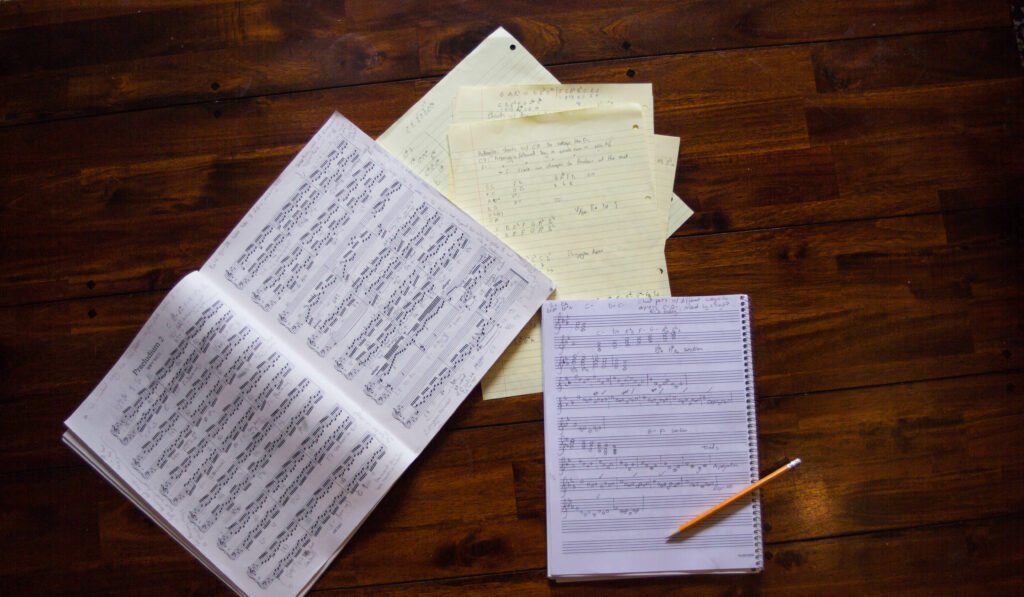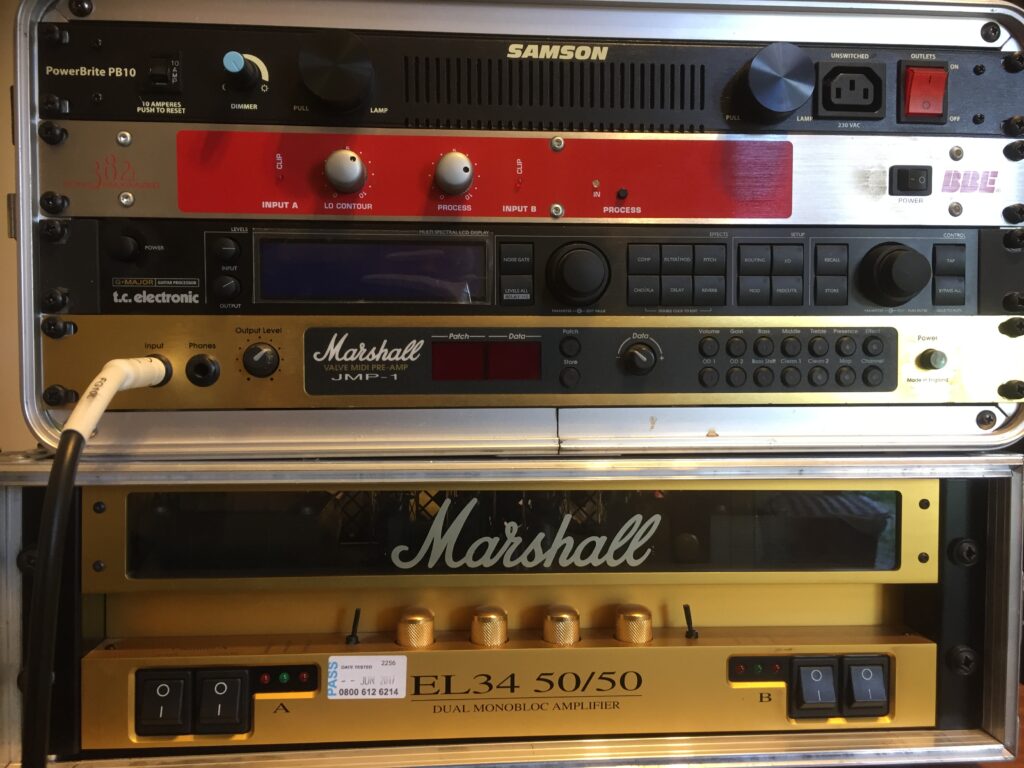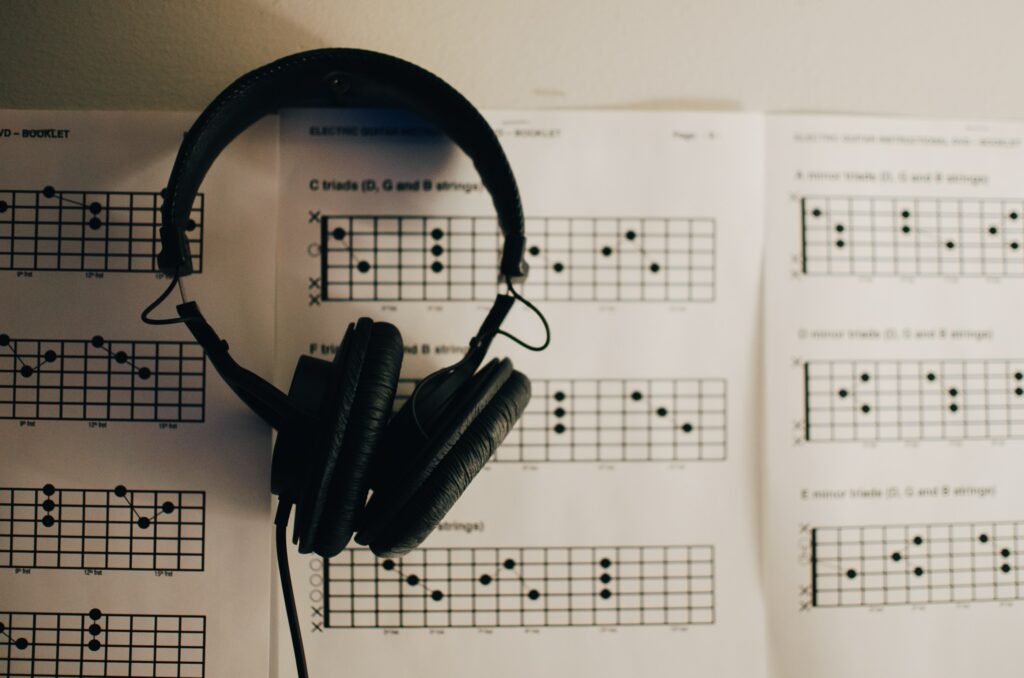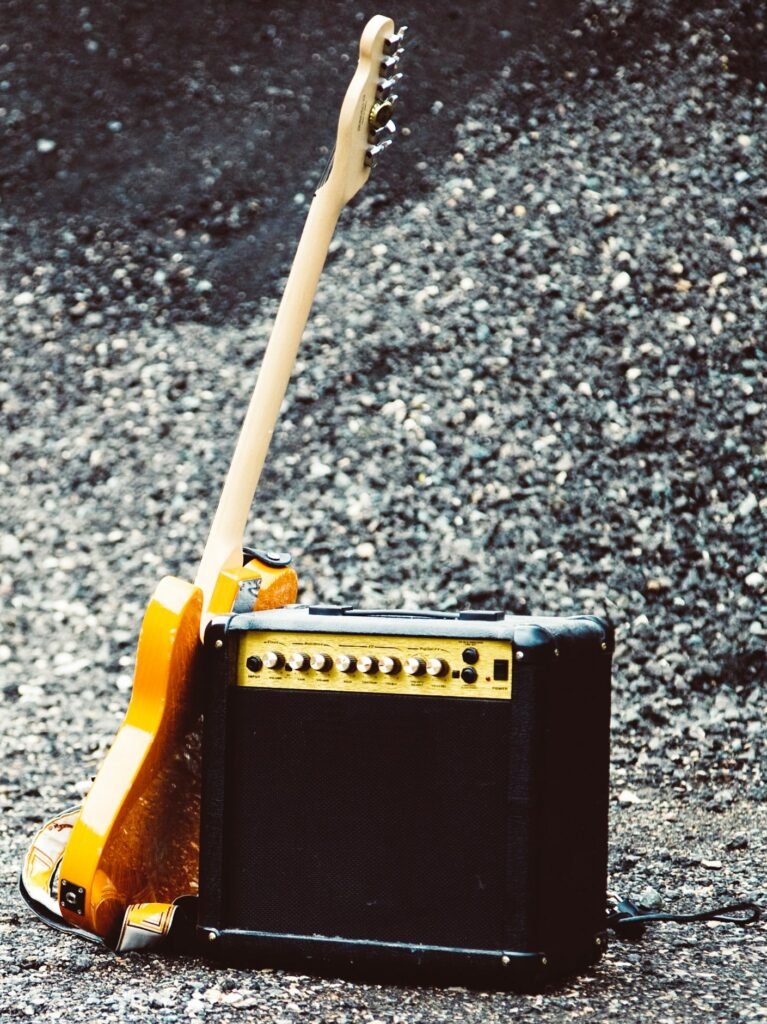50 Little Things You Can Do To Get More From Your Guitar Practice Time
Set Goals For Yourself and Guitar practice
The first step to getting more form your guitar practice time isn’t doing practice, but thinking about who you want to be as a guitarist.
Do you want to play rock guitar? Rhythm guitar? Lead guitar? Classical guitar?
Do you want to be able to compose or improvise? Read music? Or play songs from tab?
What genres do you want to play?
Do you want to play in a band?

When you choose what type of guitar player you want to become, choosing what to practice is easy.
Do you want to record covers, or record your own songs?
Answering these questions will then allow you to answer the next question, which is, “What should I practice?”
What Should I Practice?
By figuring out where you want to go as a guitarist, you can then “work backwards” to figure out what topics you need to study.
If you followed the previous step of setting goals for yourself and your practice, you will know what it is you should be practising.
You want to make sure that your practice time is effectively balanced between the different topics that you want to cover.
Let’s do some quick examples.
If you want to play rock songs, then you will need to study:
- Rhythm
- Chords
- The minor pentatonic scale
If you want to compose your own songs, you will need to study:
- Harmony
- Melody
- Form
Knowing where you want to go will help you choose the right things to practice.
If you are stuck figuring out what to practice, hire a teacher to help you.
Practicing Chords
When practising chords you need to take your time to make sure that you really understand the chord shape. One way you can learn chords faster is by hold the chord down really hard for 6-8seconds. You should be holding the chord down so hard that your finger nails turn yellow.
Repeat this 5-6 times for a few minutes every day. This can make a good warm up exercise. You will soon find that your fingers start to “find” the chord shape a bit easier.
When practising chord changes, take your time moving between chords. If you try and do the change too fast, you will find your fingers fly about everywhere and do all sorts of things that you don’t want them to do.
By taking your time, you can control how each finger moves, from one chords to the next.
When learning new chords, you will find it helpful to practice the chords in different combinations. For example, if you can play:
Em - Am - C
And you can play the transition to Am fine, that doesn’t necessarily mean that you will be able to play the Am in the following progression:
G - Am - D
Because your fingers are starting in different places. By practising the Am chord in different progressions, you will get better quality practice at moving to and from the chord.
Minor key chord progressions: Check out this article with loads of different chord progressions you can try (full tabs included).
How to practice guitar scales for beginners all the way to more experienced guitarists
Tempo
Whenever I teach, students always have questions about how fast or slow they should be practising. In general, you want to practice playing accurately - speed comes from accuracy.
I like to use the following list when learning a new lick or exercise:
- Figure out what fingers to use
- Practice to get the exercise mostly memorised
- Start practice with a metronome slow enough so that you can easily play in time
- Once you can play at a given tempo 3 times in a row without making a mistake, incase the tempo by 3-5bpm and repeat
The tempo you start with at step 3 will be different for every exercise and song you learn, so you have to take a minute to figure out the right tempo for yourself.
Alternate Picking
Alternate picking is when you alternate between upstrokes and downstrokes when playing a single string. This technique is often used for playing scales, as it is a lot more efficient than only picking in single direction.
Whatever scales you are playing, you probably want to be using alternate picking.
When you are moving between strings in a scale, you want to be using sweep picking. You can read about the distinction between sweep picking and alternate picking here.
Fretting Hand Finger Independence
There are several good exercises for this. Whenever you are playing scales, whether they are scales along a single string or 3 note per string scales, you should be using different fingers for each note within a given hand position.
By being clear on the fingers you are going to use (it’s sometimes helpful to write the fingers you are going to use above the notes), you will be practising your fretting hand finger independence.
Exercises such as “the spider” exercise are a good way to specifically work on your finger independence. Here is an example of a spider exercise, with the fingers written out above the tab:
String Crossing
When your pick needs to cross a string without playing it, ensure that the pick moves in an “arc” over the string - this will avoid playing the string accidentally and causing unwanted notes to ring out.
You may need to really slow down your playing and carefully watch your picking hand to get the hang of this.
Tone Production
A lot of guitar players get confused about the concept of tone, saying things like “tone comes from the fingers”. This couldn’t be more wrong!
Tone comes mainly from your amplifier. The following things affect the tone, in order from biggest effect to least effect:
- Amplifier (including speaker cabinet)
- Effects
- Pickups
- Guitar wood

This is a MIDI controlled rack amplifier - it has fantastic tone!
So if you want to improve your tone, the best thing you can do is buy a nice amplifier.
The confusion around tone production comes from guitar players confusing tone with ornamentation. Tone is how a particular note sounds - the timbre of the note. Ornamentation is how a particular note is played - is the guitarist sliding into the note, bending into the note, using a nice vibrato, etc.
Use a music stand. It will help your posture and focus
A music stand is great, because it helps you sit in a comfortable posture. If you are trying to read your music from papers on your desk, your back and neck are hunched over your guitar - this posture is back for your back and neck.
If you use a music stand, you can sit up straight and keep a good posture while practising.
As your music stand will only have your music, you will also be more focussed - if you are reading music from your computer, then you will have other stuff going on, notifications going on and the temptation to quickly check other websites.
When you have a practice stand, all you have is your music, which keeps you focussed.
You can order music stands online from Sweetwater here.
Practice the music faster than the required tempo. When you slow down it will feel easier to play
Have you ever noticed that your “peak” speed at which you can speed tends to fluctuate? Sometimes you can hit that higher tempo and sometimes you can’t.
This difference can be even more apparent when it comes to performing, with your performance ability usually being 10%-20% lower than your bedroom practice ability.
You can compensate for this by “over practising” a song, so that you can play it at a faster tempo than you need to. This means that your performance ability is then matched to the songs tempo, rather than being a few bpm less than the speed of the song.
Rhythm
When you are practising scales, it is tempting to play a scale as a set of straight 16th notes, or as 16th triplets. This is how most scale exercises are written.
But why not make it a bit more interesting, and introduce an interesting rhythmic pattern to the scale exercise?
This will make the exercise more challenging and also more musical.
When you are learning songs and other exercises, you want to make sure you are very clear on what the rhythm is doing. Counting the rhythm out loud to your metronome is a great way to check that you are playing in time.
Make sure that your metronome is creating a “click” for every note that you need to play - this will ensure that the rhythm you are playing is accurate.

This riff has the rhythm written out underneath, making it easy to count along.
Have clear goals
If you want to make progress, you have to know what it is you are making progress towards. This is why you need goals. Your goals set your direction, what you need to practice and how seriously you need to take your practice.
If you want to play pop songs, then you know you need to learn strumming patterns, open chords and barre chords. If you want to play Iron Maiden solos, you know that you need to study alternate picking, legato and minor pentatonic scales.
It’s ok to not know exactly where you want your playing to go, but it is important to set some goals and start working towards a given direction. As you discover more about what you do and don’t like, you can change your goals and your direction.
Find a private teacher. A teacher will help you know what to practice and guide your practice time
The fastest way to improve your playing is with a good private teacher. A good teacher will give you feedback on your playing, answer your questions and help give you a structured way to progress with your playing.
Finding a good teacher can take some trial and error - don’t be afraid to try out 3-4 teachers before deciding who can help you the best.
Ideally, you want to choose a teacher based on their ability to help you learn guitar - not your location. If you have to travel a little further to attend lessons with a good teacher, it is worth it.
If you can’t find a good teacher, there are a lot of good online courses that you can take to learn specific aspects of guitar playing.
There are also some great teachers teaching online through Skype. Some people avoid Skype lessons because they think they are not as good as in person lessons. For a given teacher this is probably true - i.e. taking lessons with a great teacher in person will probably be better than taking the lessons on Skype. But, Skype lessons with a great teacher will be far better than in person lessons with a mediocre teacher.
Choose a practice location with little distractions
When practising, you want to be practising - not checking your phone, reading Facebook or watching TV. Make sure your practice environment is distraction free so that you can focus on your guitar playing.
The rate at which you progress is dependent on a few factors, including:
- Time put into practising
- What you are practising
- How focussed you are while practising
By maximising these three variables, you maximise the speed at which you’ll learn guitar.
Choose somewhere to practice where you won’t be disturbed. Minimise other distractions. Ask your family to leave you alone for a few minutes while you practice. Have your phone and email turned off.
Practice what you can’t do. Don’t just play what you can already do
A lot of guitar players think they are practising, when in actual fact they are not practising, but playing guitar. Playing guitar is playing music that you can do. Practice is when you are challenging the limits of your ability.
When you practice, you want to make sure that you are on the limits of what you can do. If you spend all your practice time playing music that you can already play… well, you aren’t going to improve.
Don’t be too critical. No one is perfect!
When you are practising, like we mentioned earlier, you are playing music that is at the edge of your ability. As such, you are going to make mistakes. This is normal and to be expected.
How we deal with this psychologically is important. Some people will get very upset with themselves when they make a mistake - this is detrimental to your playing, as this mental state will cause you to be frustrated and physically tense up your body. This approach can stem from having what is known as a fixed mindset.
A better way is to accept the mistakes and work on them, remaining emotionally indifferent to them. You’re learning, practising things that you can’t to in order to improve, if you could play them perfectly, you wouldn’t be practising in the first place!
Now, we all get frustrated from time to time, that is also normal. If you find your frustration growing, then take a break for 5 minutes. Make a cup of tea. Take a short walk. Sit in the garden and enjoy the fresh air. Then go back to your practice.
The best music comes from being relaxed while playing. You’re learning guitar, not performing heart surgery, give yourself a break.
Choose music to practice that you enjoy
While you don’t need to enjoy every piece of music that you practice and study, it is important to have some pieces that you enjoy, otherwise you’ll get bored. We don’t practice guitar so that we can play fast, we practice guitar so that we can play music we love - whether that’s songs by our favourite artists or our own compositions.
I usually advise students to work on a song they like alongside their technique exercises. Exactly how you split your practice time will depend, as we mentioned before, on your particular goals.
Be critical. Aim for perfection. Only perfect practice makes perfect
“Wait, but you said don’t be too critical!”. You have to accept mistakes that are made, but we also have to work on eliminating those mistakes so that we can improve.
When we are practising guitar, we are working on taking something that is a consciously challenging task and working to make is an effortless subconscious task. We do this by performing the same motion multiple times in a row.
When practising, you have to practice slow enough so that you can perform the motion for the exercise exactly the same way several times in a row. Only then can you increase the tempo.
Schedule a specific time for practice
Regular practice is key to improving your guitar playing. The most effective way to get practice done is to schedule it in advance. Stop what you are doing and take your calendar and pencil in, right now, when are you going to practice this week.
And when practice time comes round, get it done.
Try and schedule your practice for a time of day when it is easy for your to focus in a quiet environment. Keep your practice time as a priority, don’t let other things bump it from your schedule.
Practice Guitar Infront of a Mirror
This is a good way to check what your hands are doing. Sometimes when practising, we are so focussed on trying to play the music that we can struggle to look at how we are playing the music - using a mirror can help you see what your hands are doing from another perspective.
If this is too overwhelming, then video yourself using your phone and watch it back. Do this once a day and you will be able to keep tabs on any bad technique or odd things that your hands are doing.
Practice regularly - aim for good results
Practising regularly is key to making progress. Don’t “save” your practice for the weekend, make sure you are getting high quality practice time in during the week, ideally every day, even if it’s just for 20-30 minutes at a time.
A lot of “learning” takes place when we are asleep and our brain consolidates what we learned that day. Take advantage of this natural process by practising every day.
Guitar Practice Questions
You probably have a lot of questions about guitar practice, so we’ll try and answer as many as we can here. If you have questions that are not answered, feel free to leave a comment and I’ll get back to you.
Can You Practice Guitar Too Much?
Yes! If your feel pain in your arm, wrists, hands, elbow etc then STOP practising - you need to give your body a rest. If the pain persists the next day, then see a physiotherapist.
The sort of pains you can experience are shooting pains, stabbing sensations, burning sensations or pins and needles. You have to pay attention to these pains, as they are a warning. Do not “play through the pain”, there is no glory in injuring yourself.
If your finger tips are sore, while unpleasant, this is not dangerous and will not lead to any serious injuries, just some skin falling off every now and then.
Can You Practice Guitar Quietly?
Yes you can! You can either use an electric guitar unplugged, or use a practice amplifier that has a headphones socket on it. Use overhead headphones and be careful not to turn them up too loud - wearing loud headphones can cause hearing damage.
If you are using an acoustic guitar, you can either get a mute, or roll up an old sock and place it near the bridge, under the strings. The strings will be less resonant, which means that your guitar will be quieter.
Can You Practice Guitar All Day?
Aslong as you do not get any pains like we outlined above, you can practice guitar as much as you want. I would recommend that you take a 5 minute break every 15 minutes, and during those 15 minutes you do not play continuously but take a lot of little breaks.
Can You Over Practice Guitar?
Yes - you will know if you have practised too much because you will start to get pains in your arm / hands / wrist. Pay attention to these pains - see the question “Can You Practice Guitar Too Much?” for a better overview of the pains you can experience while practising.
How Many Hours a Day Should You Practice?
The more the better! The more you practice, the better you will become as a guitarist. One thing that is worth mentioning, is that you do not want to increase your practice time too fast.
For example, if you currently practice for 10 minutes a day and then increase your practice time to 3 hours a day, it is probable that you will injure yourself (I have injured myself doing something similar in the past).
When increasing your practice time, do so in small increments. Maybe 15-30 minutes every 5-7 days. Break the practice up over the day if possible, so that your arm and joints can rest between sessions.

Practising guitar comes with a risk of improving.
Practising 30 minutes a day will let you make progress, week by week. Practising 2-3 hours a day over several years will take your playing to levels that you can’t imagine.
What Headphones For Guitar Practice?
I like overhead headphones that have a cable. Overhead headphones will quieten the outside world a bit, allowing you to focus. Bluetooth headphones may have latency (this is a delay between the signal being transmitted and you hearing the signal) which will be incredibly off-putting - wired headphones will not have any latency.

Overear headphones with a wire are the best headphones for guitar practice.
This is why studio headphones are always wired - you won’t see bluetooth headphones in a recording studio!
What is a Guitar Practice Amp?
These are a small amplifier, designed for being used at home. When playing at home, you do not need a very loud amplifier, in fact, most practice amps tend to be too loud even at home!
Practice amps tend to be small, 5W-30W, a combo style amp, and will have some effects such as reverb and delay built in. They often have a headphones output and will sometimes allow you to have a CD / Phone / MP3 player input, so that you can play along to backing tracks through the headphones.
You only need a powerful amplifier when rehearsing with a band, or playing on stage, but having said that, with the invention of good modelling amplifiers like the Kemper and Axe-FX, that too is changing.

Practice amplifiers tend to be smaller combo amps, that play at a volume level suitable for practising at home.
What is a Good Guitar Practice Routine?
The most important thing is to have your practice time scheduled, on paper, at the start of the week. This makes it much more likely that the practice will actually happen… which is quite important if you want to improve at playing guitar!
The next most important thing is what you are going to use for your practice items. If you have a teacher, they should be setting you material each week / every few weeks to practice.
If you don’t have a teacher, you’ll have to look at your long term goals and work your way back to figure out what you need to work on this week. Choose 4-7 items that you can spend 15 minutes on at a time to practice, and work through them over the course of the week.
Guitar Practice Methods
The most common approach for practising is to slow things down. Slow down what you are doing until you can play it accurately. Students always, always, try and play things 10x faster than they can.
Make it slow, like watching grass grow. If you can’t play it three times in a row without making a mistake, you are playing too fast.
Think about the fingers that you will use, and make sure that you use the same fingers every time, you want to play the exercise exactly the same way every single time you play it.
How Often to Practice Guitar?
You want to practice 6 days out of 7 - I recommend taking one day off each week to rest your body. Practising intensely is stressful on the body, and giving it a day to recover can only be a good thing.
How Often Should I Practice Guitar as a Beginner?
6 days out of 7 is a good start. Practice for 5-10 minutes at a time, 3 times a day. Try and spread the practice out during the day and do not do it all at once. As time goes on you can increase the amount that you are practising.
Where to Practice Guitar?
Wherever you can! People often practice in their bedroom or living room. If you are serious and have the space you can make a home studio and practice and record in there.
If you are practising with a band, then you will want to goto a rehearsal studio. These studios have rooms that are soundproofed and they will also supply guitar amplifiers, vocal PA and drum kits - usually with drums you will have to bring your own breakables (cymbals, snare and pedals).
I had a student several years ago who would take his guitar to work. In his lunch break, he would goto his car and practice. I once carried a small acoustic guitar on a hiking holiday, with the guitar strapped to my backpack, hiking over mountains and practising in the evenings.
Stop making excuses, there is a way you can get more practice done.
If guitar is something you seriously want to do, then you can find the time. Can you practice at lunch time for 30 minutes? Can you watch a bit less TV and get some practice done? Can you wake up 20 minutes earlier and get some practice done?
Look at your schedule and your time and plan out when you can get some guitar practice done. Schedule your practice time like you would schedule a meeting in your calendar.
Should You Practice Guitar Every Day?
Nearly every day! Practising 6 days out of 7 is a good way to approach it, that way you get a lot of practice in and you give your body some time to rest.
The more you practice, the better you will get.
Will Guitar Lessons Make Me Better?
Almost certainly! This does depend a bit on the teacher, however, even with a mediocre teacher you will have to practice something during the week in time for the next lesson. This can be a powerful source of motivation and help ensure that your practice gets done.
A good teacher will be even better, helping give you musical and psychological insights into the guitar and how you are approaching learning it. A good teacher will help you set goals, work towards them and eventually surpass your own expectations of what you think is possible with learning guitar.
Can You Practice Without a Guitar?
You sure can - get a music theory book and read through it and work through the exercises in each chapter. This is a great way to practice when you don’t have access to guitar, for example when on holiday, or when you are on a train commuting, for example.
Guitar Practice Chair
You want a low stool, or chair, with no arms. The chair should have fixed legs and not swivel and should not be on wheels. Sit with your butt on the front edge of the seat, and keep your lower back arched and your shoulders slightly back, like you are sitting at the table at finishing school.
The tops of your legs should be roughly horizontal when sitting and you’ll want a foot stool to help keep a good posture.
Guitar Practice for Beginners
Beginners will want to practice in 10 minute sessions. Start with 2-3 sessions a day, spread out across the day. Work on something simple, like an easy riff or melody or two chords and take it really slow.
At this stage, don’t try learning entire songs, work on learning easy sections of songs that you enjoy. This will help keep you motivated.
When practising, make sure that you are apply good practice approaches to what you are working on.
Guitar Practice for Intermediate Players
Intermediate players working towards becoming advanced will want to spend 2-4 hours a day practising. Practice in 15 minute chunks, with a few minutes break between each chunk.
What you are practising should be planned out, as should your practice time, and you should know exactly how you are going to practice each item. You should be working on 4-7 practice items covering different aspects of playing guitar.
You will want specific ways to target problem areas in your playing and you should be working towards a clearly defined goal with your playing.
Guitar Practice for Technique
If you are wanting to develop your technique, you will want a series of exercises that gradually build up in complexity. You will want to practice each exercise in multiple keys across several weeks, working through 10-50 graduations of the exercise across a year.
Developing technique works exactly the same way regardless of the technique:
- Figure out how to play the exercise
- Play the exercise slowly, using exactly the same fingers every time, playing exactly the same way every time
- Use a metronome, count out loud at first along to the metronome so that you are precisely in time.
- When you can play the exercise three times in a row without a mistake, increase the tempo by 5% and repeat.
Make sure that you are relaxed while playing and be aware of any bad technique that happens. If you spot bad technique, slow things back down to retrain the exercise properly.
Guitar Practice Infront of Mirror
This can be a good way to see what your hands are doing while you practice. Sometimes while practising, we are so focussed on trying to play the music that it is difficult to observe what our hands are doing.
Using a mirror also gives a better angle to observe the hands from.
If you struggle with this, you can film yourself using your phone and watch the video back. Doing this once per day will give you valuable feedback on what you need to work on next with your technique.
Practice in the Dark
If you are playing gigs in a rock or metal band, you will find yourself on dimly lit stages. Which is half the fun! But, you want to be prepared.
Practice playing songs for your gigs in the dark, so that you can get used to playing in poorly lit situations. This will help you find any weak spots in your songs that you need to work on and get used to playing in “stage conditions”.
When you do this, make sure that you practice standing up and also practice using your pedals (if you are using pedals).
How Much Guitar Practice is Too Much?
When you start feeling pain, you have done too much guitar practice. Pain is your body warning you that it is about to get injured. When you get pains in your elbow, arm, wrist, hand or fingers; you need to take a break.
Never try and practice through the pain.
Doing yoga can help alleviate and prevent these pains.
When planning your practice time, don’t increase your time spent practising too quickly. increase your practice time by 15-30 minutes a day, only increasing the time once every week or so.
When increasing practice time, try and ensure that the time is spread out through the day rather than being done all at once.
Guitar Practice Ideas
If you want to create ideas for yourself on what to practice, you can:
- Write out a rhythm. Now play that rhythm with chords, a melody or a riff.
- Take a melody and play it in different keys.
- Take a scale exercise and play it in different positions.
- Take a riff and create different variations on the rhythm.
- Take a chord progression and play it in different ways.

The more you practice, the faster you will improve!
There are endless ways you can create ideas and variations on things to practice.
Guitar Exercises to Improve Speed and Accuracy
Whatever you are doing, use a metronome. Take the exercise you are working on and write out the rhythm underneath that exercise. Then, when playing along the metronome at slow tempos, count the rhythm out loud to the metronome while you are playing - this will ensure your rhythm is 100% accurate all the time.
You can easily create your own exercises by taking some scales, arpeggios or combinations of the two, and writing out some licks for yourself. You can use a theme for your licks, different harmonies to play over and different rhythmic ideas that you want to explore. Then write them out and practice them.
Guitar Practice With a Metronome
You should always be practising with a metronome. Take what you are working on and write the rhythm out underneath the tab, and count the rhythm out loud as you play. This will help you improve your timing and accuracy, and with time, your speed will also improve.
Guitar Practice With Backing Tracks
Backing tracks are a great way to have fun with your guitar playing and practice your improvisation. To find great backing tracks, go onto YouTube and search for “ backing track”. My personal favourite searches are “hard rock backing tracks”. The following channels have some great backing tracks:
When practising to backing tracks, you can either just jam freely, or have some goal with your playing, for example, to practice integrating a certain arpeggio with a scale, to use a certain scale position or to use a particular ornamentation technique.
Practice Guitar Without Disturbing Neighbours
The best way to avoid disturbing your neighbours when you’re practising electric guitar is to get some headphones. You can plug the headphones into your amplifier and then no-one else will hear you playing.
If you play acoustic guitar, you can get an old sock, roll it up and put it under the strings near the bride of the guitar. This will mute the strings so that they don’t ring out so much.
Guitar Practice Without an Amp
If you are playing electric guitar, you do not need an amplifier to practice, you can play unplugged. Sure it doesn’t sound as good, or as fun, as having your guitar properly amplified, but you can still practice just as good.
If you want some amplification, you can get “plug in” amplifiers, and even small amplifiers built into earphones that you can use for practising on the go.
Guitar Practice Sitting or Standing
Practising sitting down is a lot more comfortable than standing. If you are a beginner, you will want to practice sitting down while you are getting used to the instrument. If you are going to perform, then you will want to practice standing up - standing up will feel a bit different to sitting down, so you make sure you specifically practice standing.
If you are going to be using pedals, make sure you practice using those at the correct time. When preparing for a gig, the more “realistic” you can make you practice the better.
If you play electric guitar sitting, make sure you practice with your guitar on your fret side leg, with the neck pointing up around 45 degree, like a classical guitarist would hold the guitar. When you practice this way, the guitar is in a very similar position when you stand with it, which makes it easier to adapt to playing standing.

If you have a gig coming up, make sure that you practice guitar standing up.
This position is also more comfortable and better for your body than holding the guitar on your pick side leg.
Guitar Practice Fingers Hurt
If your fingers start hurting, then you need to stop practising and give them a rest. Stabbing pains, shooting pains, burning sensations or pins and needles are all warning signs that your body is wearing out and needs a rest.
If you take the rest of the day off from practising and practice lightly the next day, you should find the symptoms disappear.
If the symptoms persist, stop practising and seek advice from a physiotherapist / doctor.
Guitar Practice Warm Up
When warming up for practice, I like to do simple chord exercises, or some scale exercises. Beginners are recommended to use chromatic technique exercises as a warm up, these are great to get the brain and fingers working together.
Always make sure you are using a metronome and in a nice, distraction free where you can easily focus.
Conclusion
So there you have a ton of tips on how you can improve your guitar practice. Pick one and incorporate it into your practice routine today and start seeing improvements in your playing.